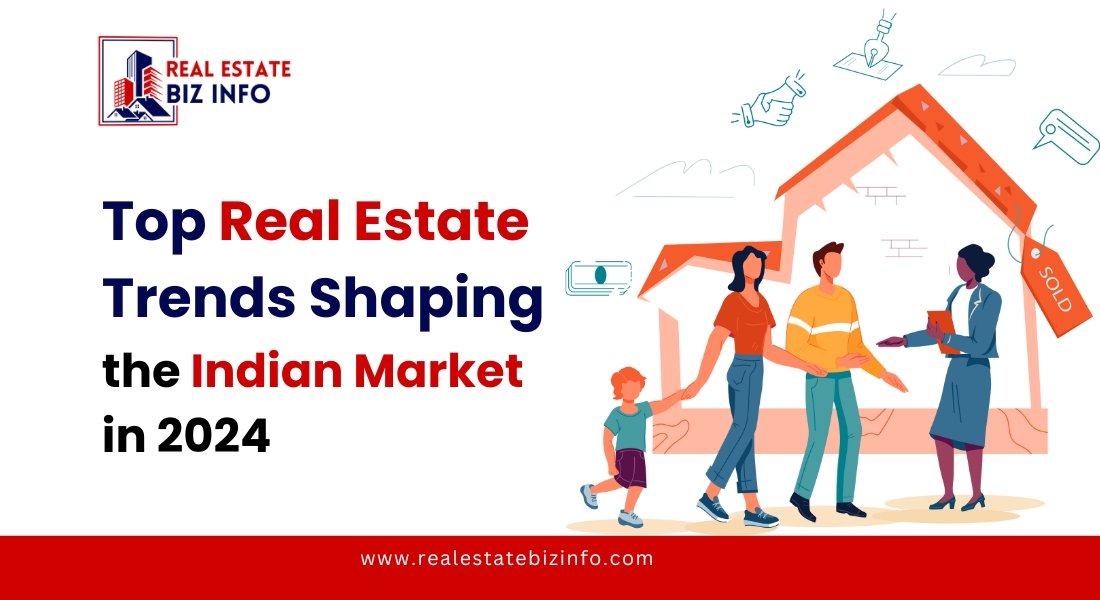The Indian real estate market continues to evolve rapidly, driven by technological advancements, economic shifts, and changing consumer preferences. As we step into 2024, several trends are redefining the industry, creating opportunities for developers, investors, and buyers alike. In this comprehensive guide, Real Estate Biz Info explores the top real estate trends that are set to shape the Indian market in 2024.
Rise of Sustainable and Green Buildings
With growing awareness about climate change and environmental conservation, sustainable real estate development has become a priority in India.
Key Features of Green Buildings:
- Use of energy-efficient materials.
- Solar power integration.
- Rainwater harvesting and waste management systems.
- Certifications such as LEED and IGBC for green compliance.
Why This Trend Matters:
- Reduced operational costs for residents.
- Increased property value due to eco-conscious demand.
- Positive environmental impact.
Technological Integration in Real Estate
Technology continues to revolutionize the real estate sector, streamlining operations and enhancing the buyer’s journey.
Popular Technologies in 2024:
- Artificial Intelligence (AI): Predictive analytics for market trends and personalized property recommendations.
- Virtual Reality (VR): Virtual property tours for remote buyers.
- Blockchain: Transparent and secure property transactions.
- Smart Home Technology: Integration of IoT devices for energy management, security, and convenience.
Impact on the Market:
- Faster and more accurate property transactions.
- Enhanced customer experience through digital tools.
Co-Living and Co-Working Spaces
The rise of shared living and working arrangements continues to reshape urban real estate.
Co-Living Spaces:
- Target audience: Millennials, young professionals, and students.
- Benefits: Affordable, community-driven, and convenient.
- Features: All-inclusive rent, high-speed internet, and shared amenities.
Co-Working Spaces:
- Growth fueled by the gig economy and remote work culture.
- Designed for freelancers, startups, and corporates.
- Features: Flexible leasing options, networking opportunities, and premium facilities.
Market Drivers:
- Urban migration.
- Rising rental costs in metropolitan areas.
- Preference for flexible living and working solutions.
Increased Focus on Affordable Housing
Affordable housing remains a key priority for the Indian government and private developers.
Government Initiatives:
- Pradhan Mantri Awas Yojana (PMAY).
- Tax benefits and subsidies for first-time homebuyers.
Trends in Affordable Housing:
- Use of pre-fabricated construction techniques to reduce costs.
- Development of integrated townships with essential amenities.
- Focus on tier-2 and tier-3 cities for affordable housing projects.
Future Prospects:
- Increased accessibility for economically weaker sections (EWS) and low-income groups (LIG).
- High demand for affordable rental housing in urban centers.
Emergence of Tier-2 and Tier-3 Cities
India’s real estate growth is no longer confined to metropolitan cities. Smaller cities are witnessing a surge in demand for residential and commercial properties.
Popular Tier-2 and Tier-3 Cities in 2024:
- Lucknow, Jaipur, Coimbatore, Indore, and Vizag.
Reasons for Growth:
- Improved infrastructure and connectivity.
- Affordable property prices compared to metros.
- Expansion of IT hubs and industrial corridors.
- Increased interest from NRIs and investors.
Luxury Real Estate Growth
India’s affluent population continues to drive the demand for luxury housing.
Features of Luxury Properties:
- Prime locations and panoramic views.
- State-of-the-art amenities such as private pools, concierge services, and smart home technology.
- Eco-friendly and sustainable designs.
Top Markets for Luxury Real Estate:
- Mumbai, Delhi NCR, Bengaluru, Hyderabad, and Pune.
Trends to Watch:
- Branded residences with global partnerships.
- High demand for second homes in scenic locations.
- Ultra-luxury apartments catering to high-net-worth individuals (HNIs).
E-Commerce and Warehousing Expansion
The rise of e-commerce has spurred the demand for warehousing and logistics spaces.
Key Drivers:
- Growth of online shopping.
- Introduction of GST, leading to consolidation of warehousing facilities.
- Rising demand for cold storage and last-mile delivery hubs.
Emerging Locations:
- NCR, Mumbai, Pune, Bengaluru, and Kolkata.
Future Prospects:
- Integration of automation and robotics in warehouses.
- Focus on sustainable warehousing solutions.
Rise of Mixed-Use Developments
Mixed-use developments combining residential, commercial, and recreational spaces are gaining popularity.
Advantages:
- Convenience of live-work-play ecosystems.
- Reduced commute times.
- Increased property value and investor appeal.
Examples:
- Integrated townships and smart cities.
- Multi-use skyscrapers in metropolitan areas.
Policy Reforms and Regulatory Changes
Government policies continue to influence real estate trends in India.
Key Policies in 2024:
- Real Estate Regulatory Authority (RERA): Ensures transparency and accountability.
- Affordable Rental Housing Complexes (ARHC): Promotes rental housing for urban migrants.
- Relaxation of Foreign Direct Investment (FDI) norms in real estate.
Impact:
- Increased trust among buyers and investors.
- Streamlined processes for developers.
- Boosted demand in previously underdeveloped segments.
Focus on Wellness Real Estate
Post-pandemic, wellness-oriented properties have gained traction among buyers.
Features of Wellness Real Estate:
- Open green spaces and parks.
- Air purification systems and natural ventilation.
- Proximity to healthcare facilities.
- Amenities like yoga studios, gyms, and wellness centers.
Why It’s Trending:
- Growing focus on health and well-being.
- Increased demand for serene and nature-inspired living environments.
Real Estate Investment Trusts (REITs)
REITs have emerged as a popular investment avenue, offering an opportunity to invest in income-generating real estate assets.
Benefits of REITs:
- Regular income through dividends.
- Diversification of investment portfolio.
- Liquidity compared to traditional real estate investments.
Future Outlook:
- Growth in office space and retail REITs.
- Expansion into new asset classes like warehouses and data centers.
Data Centers as a Real Estate Asset
With the rise of digitization, data centers have become a lucrative asset class in Indian real estate.
Drivers of Demand:
- Growth of cloud computing and digital payments.
- Data localization requirements.
- Increased internet penetration and 5G rollout.
Key Locations:
- Mumbai, Chennai, Bengaluru, and Hyderabad.
Future Prospects:
- Integration of renewable energy in data center operations.
- Expansion into tier-2 cities.
Conclusion
The Indian real estate market in 2024 is a dynamic landscape, shaped by innovative trends and evolving consumer demands. From sustainable developments and technological integration to the rise of co-living spaces and tier-2 cities, the sector offers diverse opportunities for stakeholders. As these trends continue to unfold, staying informed is key to making the most of India’s thriving real estate market.
For the latest insights, market updates, and expert advice, visit Real Estate Biz Info. Empower your real estate journey with reliable and comprehensive information.




